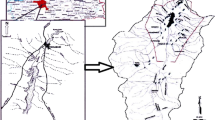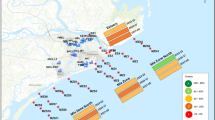Abstract
The Black Sea receives uncontrolled and irregular fresh water for the production of thermal and hydro energy and the use of coastal areas. Transportation, untreated domestic, industrial and agricultural wastes, fall out into rivers or directly into the sea. In order to discuss and assess further pollution loads and possible management techniques for the coastal pollution problems of Black Sea, different mathematical modeling techniques can be used. Mathematical models are also useful tools to save time and money, as well as to help solve ecological problems more easily and to select an appropriate management alternative for sustainable management. AQUATOX is one of the affinity models for aquatic ecosystems. AQUATOX seeks to determine the fate of various pollutants, such as nutrients and organic chemicals, and their impact on the ecosystem, including fish, invertebrates and aquatic plants. In this study, samples collected from five different points in the organized industrial zone in Samsun province in August and December 2017. pH, conductivity, dissolved oxygen, chemical oxygen demand, total organic carbon, total-N, total-P were carried out in water samples. The model was run for dissolved oxygen, total phosphorus and total nitrogen from the measured parameters, and the results were evaluated by adding to program inputs. The model was run to determine the contribution of contamination in aquatic ecosystems to the assessment of ecological risk. The models are thought to be an essential structure for ecosystems to determine their ecological protection levels.





Similar content being viewed by others
References
APHA–AWWA (2005) Standard methods for the examination of water and wastewater, 17th edn. American Public Health Association/American Water Works Association/Water Environment Federation, Washington, DC
Barber MC (2001) Bioaccumulation and aquatic system simulator (BASS) user’s manual, beta test version 2.1. 600/R-01/035. US Environmental Protection Agency, Athens
Bartell SM, Lefebvre G, Kaminski G, Carreau M, Campbell KR (1999) An ecological model for assessing ecological risks in Quebec rivers, lakes, and reservoirs. Ecol Model 124:43–67
Chapra SC, Pelletier GJ, Tao H (2007) QUAL2K: a modeling framework for simulating river and stream water quality, version 2.07: documentation and users manual. Civil and Environmental Engineering Department, Tufts University, Medford
Chen S, Chen B, Fath BD (2013) Ecological risk assessment on the system scale: a review of state-of-the-art models and future perspectives. Ecol Model 250:25–33
Clough JS (2004) AQUATOX: modeling environmental fate and ecological effects in aquatic ecosystems, vol 3, user’s manual for the BASINS (version 3.1) extension to AQUATOX release 2. EPA-823-R-04-003. US Environmental Protection Agency, Office of Water, Washington, DC
DeAngelis DL, Bartell SM, Brenkert AL (1989) Effects of nutrient cycling and food-chain length on resilience. Am Nat 134:778–805
Di Toro DM (2001) Sediment flux modeling. Wiley, New York, p 624
Di Toro DM, Fitzpatrick JJ, Thomann RV (1983) Water quality analysis simulation program (WASP) and model verification program (MVP)-documentation. Hydroscience, Inc. for USEPA, Duluth
Lei B, Huang S, Li T, Qiao M, Wang Z (2008) Prediction of the environmental fate and aquatic ecological impact of nitrobenzene in the Songhua River using the modified AQUATOX model. J Environ Sci 20:769–777
Li X, Gao Y, Qian H, Wu H (2017) Groundwater vulnerability and contamination risk assessment of the Weining Plain, using a modified DRASTIC model and quantized pollution loading method. Arab J Geosci 10:469
Martin JL, Ambrose RA, Wool TA (2006) WASP7 benthic algae-model theory and user’s guide. US Environmental Protection Agency, Athens
Novotny, V (2006) Review of watershed ecological models, technical report no. 7. Boston, April 2006, p 7
Ouchir N, Ben Aissa L, Boughdiri M, Aydi A (2016) Assessment of heavy metal contamination status in sediments and identification of pollution source in Ichkeul Lake and rivers ecosystem, Northern Tunisia. Arab J Geosci 9:539
Park RA, Clough JS, Wellman MC (2008) AQUATOX: modeling environmental fate and ecological effects in aquatic ecosystems. Ecol Model 213:1–15
Park RA, Clough JS, Wellman MC (2013) AQUATOX: modeling environmental fate and ecological effects in aquatic ecosystems. Office of Water of United States Environmental Protection Agency, Washington, DC, pp 302–344
Rykiel EJ Jr (1996) Testing ecological models: the meaning of validation. Ecol Model 90:229–244
Schol A, Kirchesch V, Bergfeld T, Muller D (1999) Model-based analysis of oxygen budget and biological processes in the regulated rivers Moselle and Saar: modelling the influence of benthic filter feeders on phytoplankton. Hydrobiologia 410:167–176
Schol A, Kirchesch V, Bergfeld T, Scholl F, Borcherding J, Muller D (2002) Modelling the chlorophyll content of the River Rhine interaction between riverine algal production and population biomass of grazers, rotifers and zebra mussel, Dreissena polymorpha. Int Rev Hydrobiol 87:295–317
Soylu A (2011) The impact of industrial emissions on local heavy metal content of cattle milks in Samsun, master thesis. Ondokuz Mayıs University, Food Engineering Department, Samsun
Traas TP, Stab JA, Kramer PRG, Cofino WP, Aldenberg T (1996) Modeling and risk assessment of tributyltin accumulation in the food web of a shallow freshwater lake. Sci Technol 30:1227–1237
Traas TP, Janse JH, Aldenberg T, Brock JT (1998) A food web model for fate and direct and indirect effects of Dursban 4E (active ingredient chlorpyrifos) in freshwater microcosms. Aquat Ecol 32:179–190
Traas TP, Janse JH, Van den Brink PJ, Aldenberg T (2001) A food web model for fate and effects of toxicants and nutrients in aquatic mesocosms. Model description. Report 601516 006. RIVM, Bilthoven
US Environmental Protection Agency, USEPA (2010) AQUATOX short course. In: SETAC meeting, Portland, 7 Nov 2010
US Environmental Protection Agency, USEPA (2014) Modeling environmental fate and ecological effects in aquatic ecosystems, vol 1: user’s manual, EPA-820-R-14-005. United States Environmental Protection Agency Office of Water, Washington, DC
Wool, TA, Ambrose, RB, Martin, JL, Comer, EA (2004) Water quality analysis simulation program (WASP) version 6.0 DRAFT: user’s manual. US Environmental Protection Agency-Region 4, Atlanta
Zhang L, Liu J, Li Y, Zhao Y (2013) Applying AQUATOX in determining the ecological risk assessment of polychlorinated biphenyl contamination in Baiyangdian lake, North China. Ecol Model 265:239–249
Acknowledgements
This study was supported by Ondokuzmayıs University PYO.MUH.1901.17.001 scientific research Project.
Author information
Authors and Affiliations
Corresponding author
Ethics declarations
Conflict of interest
The authors declare that they have no conflict of interest.
Additional information
Editorial responsibility: M. Abbaspour.
Rights and permissions
About this article
Cite this article
Şimşek, A., Küçük, K. & Bakan, G. Applying AQUATOX for the ecological risk assessment coastal of Black Sea at small industries around Samsun, Turkey. Int. J. Environ. Sci. Technol. 16, 5229–5236 (2019). https://doi.org/10.1007/s13762-019-02251-4
Received:
Revised:
Accepted:
Published:
Issue Date:
DOI: https://doi.org/10.1007/s13762-019-02251-4




